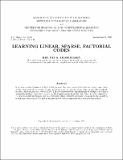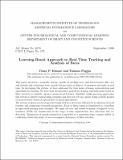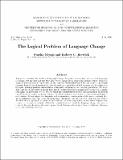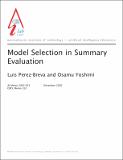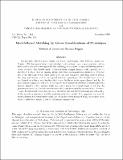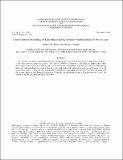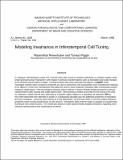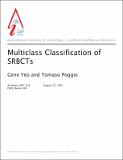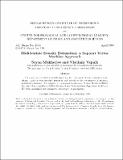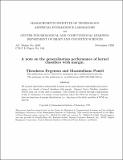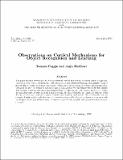Browsing CBCL Memos (1993 - 2004) by Title
Now showing items 56-75 of 123
-
Learning from Incomplete Data
(1995-01-24)Real-world learning tasks often involve high-dimensional data sets with complex patterns of missing features. In this paper we review the problem of learning from incomplete data from two statistical perspectives---the ... -
Learning Linear, Sparse, Factorial Codes
(1996-12-01)In previous work (Olshausen & Field 1996), an algorithm was described for learning linear sparse codes which, when trained on natural images, produces a set of basis functions that are spatially localized, oriented, ... -
Learning-Based Approach to Estimation of Morphable Model Parameters
(2000-09-01)We describe the key role played by partial evaluation in the Supercomputing Toolkit, a parallel computing system for scientific applications that effectively exploits the vast amount of parallelism exposed by partial ... -
Learning-Based Approach to Real Time Tracking and Analysis of Faces
(1999-09-23)This paper describes a trainable system capable of tracking faces and facialsfeatures like eyes and nostrils and estimating basic mouth features such as sdegrees of openness and smile in real time. In developing this ... -
The Logical Problem of Language Change
(1995-12-01)This paper considers the problem of language change. Linguists must explain not only how languages are learned but also how and why they have evolved along certain trajectories and not others. While the language ... -
Measure Fields for Function Approximation
(1993-06-01)The computation of a piecewise smooth function that approximates a finite set of data points may be decomposed into two decoupled tasks: first, the computation of the locally smooth models, and hence, the segmentation ... -
Model Selection in Summary Evaluation
(2002-12-01)A difficulty in the design of automated text summarization algorithms is in the objective evaluation. Viewing summarization as a tradeoff between length and information content, we introduce a technique based on ... -
Model-Based Matching by Linear Combinations of Prototypes
(1996-12-01)We describe a method for modeling object classes (such as faces) using 2D example images and an algorithm for matching a model to a novel image. The object class models are "learned'' from example images that we call ... -
Model-Based Matching of Line Drawings by Linear Combinations of Prototypes
(1996-01-18)We describe a technique for finding pixelwise correspondences between two images by using models of objects of the same class to guide the search. The object models are 'learned' from example images (also called ... -
Modeling Invariances in Inferotemporal Cell Tuning
(1998-03-01)In macaque inferotemporal cortex (IT), neurons have been found to respond selectively to complex shapes while showing broad tuning ("invariance") with respect to stimulus transformations such as translation and scale changes ... -
Modeling Stock Order Flows and Learning Market-Making from Data
(2002-06-01)Stock markets employ specialized traders, market-makers, designed to provide liquidity and volume to the market by constantly supplying both supply and demand. In this paper, we demonstrate a novel method for modeling ... -
Multiclass Classification of SRBCTs
(2001-08-25)A novel approach to multiclass tumor classification using Artificial Neural Networks (ANNs) was introduced in a recent paper cite{Khan2001}. The method successfully classified and diagnosed small, round blue cell tumors ... -
Multivariate Density Estimation: An SVM Approach
(1999-04-01)We formulate density estimation as an inverse operator problem. We then use convergence results of empirical distribution functions to true distribution functions to develop an algorithm for multivariate density estimation. ... -
Neural Networks
(1996-03-13)We present an overview of current research on artificial neural networks, emphasizing a statistical perspective. We view neural networks as parameterized graphs that make probabilistic assumptions about data, and view ... -
A Note on Object Class Representation and Categorical Perception
(1999-12-17)We present a novel scheme ("Categorical Basis Functions", CBF) for object class representation in the brain and contrast it to the "Chorus of Prototypes" scheme recently proposed by Edelman. The power and flexibility ... -
A Note on Support Vector Machines Degeneracy
(1999-08-11)When training Support Vector Machines (SVMs) over non-separable data sets, one sets the threshold $b$ using any dual cost coefficient that is strictly between the bounds of $0$ and $C$. We show that there exist SVM ... -
A Note on the Generalization Performance of Kernel Classifiers with Margin
(2000-05-01)We present distribution independent bounds on the generalization misclassification performance of a family of kernel classifiers with margin. Support Vector Machine classifiers (SVM) stem out of this class of machines. The ... -
Notes on PCA, Regularization, Sparsity and Support Vector Machines
(1998-05-01)We derive a new representation for a function as a linear combination of local correlation kernels at optimal sparse locations and discuss its relation to PCA, regularization, sparsity principles and Support Vector Machines. ... -
Object Detection in Images by Components
(1999-08-11)In this paper we present a component based person detection system that is capable of detecting frontal, rear and near side views of people, and partially occluded persons in cluttered scenes. The framework that is ... -
Observations on Cortical Mechanisms for Object Recognition andsLearning
(1993-12-01)This paper sketches a hypothetical cortical architecture for visual 3D object recognition based on a recent computational model. The view-centered scheme relies on modules for learning from examples, such as Hyperbf-like ...


